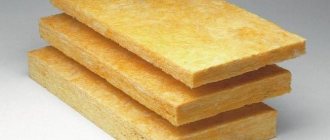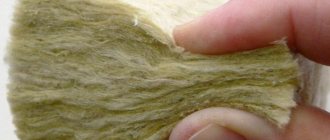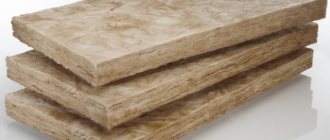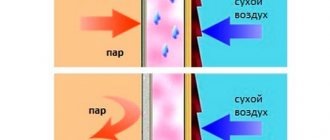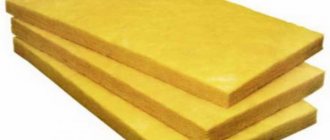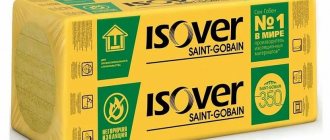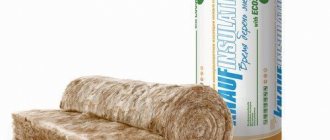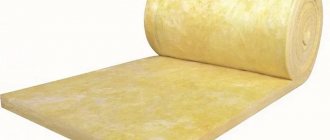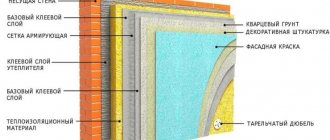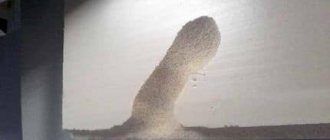Depending on what material is used as a raw material for the manufacture of natural insulation, the weight of the mineral wool changes. The main indicator that will allow the consumer to determine how much weight they will have to work with when laying thermal insulation material is density, which is defined as the weight of mineral wool in an amount of 1 cubic meter. By and large, the weight of mineral wool slabs used in private house construction and renovation is relatively insignificant and does not affect either the speed of their installation or the ease of performing technological operations.
What determines the weight of the mineral wool used?
In the process of producing insulation, offered to customers under the general name of mineral wool, both basalt rocks can be used, which makes it possible to call the final product basalt wool, and waste from the metallurgical industry - slag, the weight of which is significantly less than basalt, which affects the weight of the insulation.
The weight of mineral wool depends on its density, which influences the choice of material depending on the area of application - loaded or unloaded surfaces. For the most part, this figure can range from 35 to 100 kg/cubic meter. Considering that the size of the insulation boards used is on average 0.6 square meters, the weight during installation is also insignificant. The term “density” in some cases can be replaced by the name “volumetric weight of the minislab”, which fully corresponds to the definition of density and represents the weight of 1 cubic meter of insulation.
Brief description of the material
Cotton wool for wall insulation is the optimal price-quality ratio when creating comfortable living conditions. It consists of a large number of fibers that are obtained by specific processing. They can be made of glass, slag, stone. The density of any mineral wool, measured in kg per m3, also depends on the material of manufacture. Insulation has a number of advantages, including:
- Easy to install. Mineral wool can be presented in the form of a roll or slabs that hold their shape.
- The light weight of the material allows it to be used for floors without weighing them down.
- Convenience of subsequent finishing. This indicator depends, among other things, on the density of the insulation.
- Environmentally friendly - mineral wool is created from natural materials, which allows it to be completely safe.
- The material is a good sound insulator.
- Non-flammable - it melts but does not burn.
There are also disadvantages and they should be taken into account when insulating with mineral wool:
- Glass and slag wool are very prickly, this must be taken into account during the installation process. Stone wool is practically free from this drawback.
- The material, together with air, allows moisture to pass through, which leads to its loss of its technical characteristics. To avoid this, it is necessary to isolate the insulation from moisture.
- To purchase high-density mineral wool, you will have to spend a lot of money, but the result will exceed expectations.
Insulation structure with different densities
How much do Rockwool slabs weigh?
The weight of mineral wool from Rockwool, a popular insulation manufacturer in our country, depends on the density of the thermal insulation material that the buyer chooses to perform a certain type of work:
- Weight of Rockwool Acoustic Butts, density 45 kg/cu.m. meter, dimensions 1000 x 600 x 50 mm is no more than 1.35 kg.
- Weight of Rockwool Acoustic Butts, density 37 kg/cu.m. meter, dimensions 1000 x 600 x 50 mm is no more than 1.1 kg.
- The weight of Rockwool Light Butts Scandic mineral wool, density 37 kg/cubic meter, dimensions 1000 x 600 x 50 mm, is no more than 0.75 kg.
The mass of mineral wool can differ radically when using combined types of insulation - Rockwool Fire Butts foil plate, density 110 kg / cubic meter. meter, dimensions 1000 x 600 x 30 mm, weighs within 2 kilograms. The weight also depends on the thickness of the insulation used - Rockwool Light Butts Scandic, density 37 kg/cu. meter, dimensions 1000 x 600 x 100 mm, weighs about one and a half kilograms.
The weight of the insulation does not significantly affect the application features. Of greater importance, of course, is the density of the material. In addition, knowing the density parameter and packaging volume, you can easily calculate the weight of the product.
The density of insulation can vary significantly depending on the brand, composition, and the use of various synthetic elements. For example, with a density of 28-45 kg/m 3, the weight of extruded polystyrene foam (one cubic meter of material) will be 28-45 kg.
The weight of ordinary polystyrene foam is 15-35 kg (one cubic meter)
The density of this material depends on the so-called product classes (their characteristics include not only density, but also strength, water absorption, etc.): 31, 31C, etc. For example, extruded polystyrene foam 35 has a density of approximately 30 kg/m 3 .
The weight of mineral wool (1m3), as a rule, depends on the purpose.
For example, rigid boards, which are produced by adding special synthetic additives (resins) to fibers, are used to insulate walls and ceilings - those areas where the greatest density of the material is required. The density of these plates is 175-200 gc/m3. They are marked respectively PZh-175, PZh-200. Other density indicators are provided for a ventilated facade and for insulation “under plaster” 100-125 kg/m 3.
Application
1. Installation of heat-insulating coating in flat roofs and multi-level layers.
2. Thermal insulation of pipeline communications, tanks, gas pipelines and technical equipment in many industrial sectors.
3. Insulation in 3-layer sandwich panels, as well as concrete or reinforced concrete materials.
4. Unloaded insulation in building envelopes.
6. Thermal insulation of ventilated facade structures.
7. Entrance door filler.
Types of mineral wool
All types have good fire resistance. The most popular are glass and mineral wool. The basis of stone mineral wool contains rocks of basalt groups with an admixture of metallurgical substances. The structure of glass wool is filled with glass fiber, using quartz sand and old glass substances.
In 2 cases, phenol-formaldehyde resin is used as binding components. According to research, this substance can harm human health. But in comparison with the popular material chipboard, which contains the same resins, its quantity is 20 times less.
GOST
The official standard applies to stone wool made from substances of rocks of the gabbro-basalt group, as well as their identical substances, sedimentary rocks, volcanic, metallurgical residues, industrial silicate slags, alloys intended for the production of heat-insulating, sound-proofing and sound-absorbing materials.
Stone wool can be used as a heat-insulating substance in the construction industry and industrial production for finishing surfaces with a temperature range from -180 C to +700 C.
Types of mineral wool
3. Vertically layered.
4. Horizontally layered.
The main component of the material is basalt. It acts as a binder, which can be urea resins, bitumen, phenolic alcohols, clay and starch.
In the process of making mineral wool based on rocks of molten mineral materials, thin fibers of 1–3 microns with a thickness of 50 mm are obtained. To improve strength, molten charge or limestone can be added to the molten basalt fibers. Mineral wool substances repel moisture, thereby protecting the thermal insulation properties.
Compound
Stone wool has a fibrous structure, similar in composition to basalt. It is considered a natural material, 80 percent consists of the earth's crust, and the wool itself is made from molten volcanic rocks.
Balzac fiber is produced in factories, but its composition is also similar to the chemical structure of rocks. It also contains sand, soda, limestone, borax and dolomite. When finished, the material has impressive dimensions and is permeated with air through and through. For storage and transportation, mineral wool is compressed to a sixfold state.
Many manufacturers are trying to improve the quality of the product by making changes to the composition and production process. To increase rigidity, the slabs are stitched, impregnated with bitumen and phenols with the addition of asbestos. If the composition contains additional substances, this may change the characteristics of the product. Bitumen prevents damage from insects and fungi, protects the product from moisture and provides additional strength.
Thermal conductivity coefficients
All durable components are gradually heated, and then cooled, in compliance with the intervals, the temperature regime of the internal structure and surface of the material. The thermal insulation qualities of mineral wool are demonstrated by the thermal conductivity coefficient. Its smallest value ensures maximum preservation of thermal conductivity. Often the coefficient values are pre-specified by the manufacturer. The value of the coefficient is determined in laboratory conditions.
Thermal water values vary around 0.032 W/(m*K). The latter indicator is found only in high-quality insulation materials.
Mineral wool sizes
Manufacturers present 3 types of mineral wool, each of which has its own type of raw material, namely
3. Basalt mineral wool.
Sheets
Mineral wool rolled into rolls is produced in the form of a large piece, pre-cut and completed. The dimensions of the material are indicated on the packaging, since many manufacturers have different sizes. Thickness can vary from 40 to 200 mm, width from 565 to 610 mm, length about 1170 mm. The thickness of rigid slabs for hydro and thermal insulation varies from about 50–170 mm, the width of the product is about 1190 mm, and the length is 1380 mm.
Roll material
Mineral wool in this format is ideal for thermal insulation of large areas, since the rolls contain a large amount of material. As a rule, the width of the materials varies between 50–200 mm, the length of the sheet is about 7000–14000 mm, and the width is approximately 1200 mm. The material is easy to cut and adjust to the size of the room.
Mineral wool in cylinders
Designed for waterproofing hydraulic lines. The basis of this type of mineral wool includes: foil, fiberglass mesh and basalt. The structure can withstand high temperatures up to 250 C. The width of the product generally varies between 12–324 mm, length about 1200 mm, with a thickness of 20–80 mm. The exact dimensions are indicated on the packaging of the material. Mineral wool in cylinders is intended for thermal insulation of heat exchange systems and heating communications. Diameter, thickness and length are selected in accordance with the size of the pipes
The mass of mineral wool varies depending on the substances filling it. To determine what weight the builder will be dealing with, you should pay attention to the density of the material, which can also be found as the mass of mineral wool per 1 cubic meter. This figure can vary from 35 to 100 kg per 1 cubic meter. The average weight of insulating boards is 0.6 cm. In the process of performing technical operations, weight does not play a significant role.
Manufacturers' products have different weights, on average this figure varies from 37 to 45 kg with sizes no more than 1.35 kg, and depends on the density of the thermal insulation material. Its weight changes significantly with a combined approach to insulation. In this case, the thickness of the insulation used is decisive.
Rockwool insulation in rolls
Rockwool lamella rolls.
Types of Rockwool insulation in rolls are divided into two categories:
Solid rolls are long strips of insulation without joints. They are presented in a line called:
- Tech Mat – 43 kg/m. cube, 0.034 W/m*S. Used for thermal insulation of pipelines and technological equipment, can be with foil;
- Wired Mat – 50 kg/m. cube, stitched with galvanized wire;
- Domrock, Megarock, Multirock.
Lamella rolls are narrow rectangular pieces of thermal insulation that are attached to a foil base. This approach allows you to roll denser materials. These include Klimafix and Lamella Mat. The dimensions of Rockwool insulation differ only in length and thickness, and the standard width for all is 1 m.
Regardless of whether Rockwool thermal insulation is produced in mats or rolls, the entire line is quite versatile. The main characteristics are approximately the same, only the density of the material and the presence of foil or reinforcement differ. There are also two-layer and single-layer insulation, of course, different sizes.
The characteristics of physical bodies make it possible to determine their functionality, predict the duration of their operational life, and identify their features. With regard to materials for thermal insulation based on mineral wool, one of the main quality indicators is density, which is also the specific gravity of the insulator.
The unit of measurement for density (volume weight) is kg/m3. The scope and performance of the material directly depends on this indicator.
